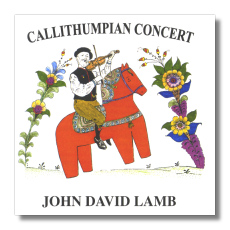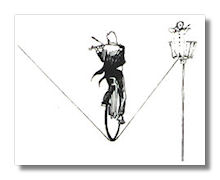
The Internet's Premier Classical Music Source
Related Links
-
Other Album Notes:
Late Harvest
Swedish Design
Bon appétit!
Bird's Eye View
Saxophone Project
-
Find CDs & Downloads
Amazon - UK - Germany - Canada - France - Japan
ArkivMusic - CD Universe
Find DVDs & Blu-ray
Amazon - UK - Germany - Canada - France - Japan
ArkivMusic-Video Universe
Find Scores & Sheet Music
Sheet Music Plus -
Recommended Links
Site News
Liner Notes
John David Lamb - Callithumpian Concert

NÄCKENS VÄNNER NV-2
CARICATURES is a set of five short pieces that were originally conceived as humorous sketches of my friends and teachers. Some of the material was jotted quickly into my sketch books as early as 1952 with further sketches added throughout the next dozen years. The piece first took shape as an orchestral suite in 1966 while I was on sabbatical in northern California. Twenty years later I revisited the material, made a complete revision, and produced the present suite for clarinet and piano. In these pieces it is easy to hear the voices of some powerful influences on my youth: Stravinsky, Berg, Orff, and of course my teacher, Dārziņš.

ASYMMETRICAL DANCES is a set of sixteen violin duets from which I selected ten for this recording. I call them "asymmetrical" because of their un-square phrase structure and quirky rhythm. Over a period of several years I wrote them to play with my friends when we ran out of Bartók, and it is easy to hear overtones of the original model. The first duets are short and technically simple, but as my own technique improved, the duets became longer and more intricate. As far as I know, this is the first professional performance of these pieces.
My quartet, NIGHT MUSIC is about the enchanted night far up in the Swedish summer pastures and about the joyful return to the social life of the village at the end of the season. The two movements are subtitled fäbodlåt and polska; this might need a little explanation.
The tradition has died out, but until well into the twentieth century Swedish farmers in the province of Dalarna took their live stock to summer pastures in the forests and mountains. The summer farm, or fäbod, was perhaps a long day's walk from the village, and it was most often the job of the unmarried women to stay up there with the cows all summer while the men of the village were away in the cities working for wages. The fäbod life was often hard and lonely. The women made cheese and tended the herd during the day, but during the long Northern twilight, they could hear and imagine the wild animals and spirits that lived in the woods around them. This experience gave rise to a rich treasure of songs, cow calls, and instrumental music which survives to this day.
Polska is a characteristic dance type in Scandinavia. It was known in Sweden at least four centuries ago and is thought to have come originally from Poland - hence the name. Although it is in 3/4 time, polska is very different from waltz. The first and third beats are stressed, and the second beat is often played fractionally early so as to give a feeling of up-lift. Polska is generally a couple dance in which the partners make one complete turn for every bar of music. In the early farming culture, nearly every little village in Sweden had its own special variant of the polska dance, and local fiddlers played in highly personal styles that came to be identified as regional dialects. Times have changed and dancing does not retain the village significance it used to have, but even today polska lives and thrives owing to the enthusiasm of folkdancers and fiddlers all over the country.
We all play many roles and turn a number of different faces to the world. PERSONAE is another set of caricatures – this time a series of miniature self-portraits reflecting some of my own roles in life. Jack Finney is my portrayal of the village innocent, ever optimistic and naive, yet somehow effective if only through blind luck and good will. This character first appeared in my chamber opera, St. George and has always been a powerful part of my identity. Masks is a struggle between duty and dreams; it is meant to depict the difficult dual roles of family man and would-be artist, each one striving to assert an identity. Epitaph reveals a seldom-heard somber mood and a look ahead toward an imagined final scene. Last Waltz is the shameless confession of an incurable romantic. The material for this work covers a period of forty years, the first sketch of Epitaph dating from 1959. The final collection of sketches and working out of PERSONAE as a complete composition took place in the spring of 1999. My first major work was a concerto for horn in 1958, and this piece rounds out my life-long love affair with this wonderful instrument.

Notes by J.D. Lamb
JOHN DAVID LAMB – Born Portland, Oregon, 1935. Raised in Yakima, Washington. Public school education. Married 1954, two daughters. B.A. San Francisco State 1956; M.A. in music University of Washington 1958. Private study with Latvian nationalist composer, Volfgangs Dārziņš, Seattle, 1956-1960.
STYLE AND CONTENT
It is an odd feature of our times that a melody-driven composer feels called upon to defend music that does what music has always done. But these are odd times. This CD contains only traditional chamber music: clearly defined material, triadic harmony, development, recapitulation – all the familiar landmarks.
For fifty years I have tried to compose straight-forward music that lies well for the instruments and is accessible to listeners. If I have any gift at all it would seem to be in the creation of simple tunes, and this is probably why I think tunes are so terribly important. No composer was ever beloved on account of his clever development sections. Most concert goers want something they can take home and go to bed with, and it is strong material, not intellectual devices that provide this.
Artists can choose to be accessible or choose to be prickly, or even sometimes one and sometimes the other. I do not believe that being accessible is the same as pandering. Nor do I believe that a prickly piece is necessarily more sophisticated, profound, or content-laden because it is obscure. The important thing is that the content should bear some relationship to the amount of effort required to get at it. My music is meant to be enjoyed rather than quarried and analyzed.
I try to keep in mind that at the same time that I am an artist, I am also an entertainer whose art requires that the consumer sit quietly for a while. This is a considerable responsibility, and as I write, I have in the back of my mind: Is this really worth sitting still for? As you listen to these pieces, I hope you will savor the tunes, enjoy the interplay, and feel that they are worth your time.
Credits
Art – Sydney Stibbard
Recording, editing and mastering – Al Swanson
Production – J.D. Lamb
All selections licensed by ASCAP
Published byNÄCKENS VÄNNER
1907 East Blaine
Seattle, WA 98112
©® 1999 by John David Lamb













